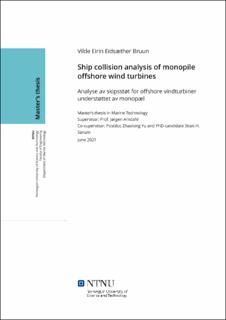| dc.contributor.advisor | Amdahl, Jørgen | |
| dc.contributor.advisor | Yu, Zhaolong | |
| dc.contributor.advisor | Sørum, Stian H. | |
| dc.contributor.author | Bruun, Vilde Eirin Eidsæther | |
| dc.date.accessioned | 2021-09-24T16:56:50Z | |
| dc.date.available | 2021-09-24T16:56:50Z | |
| dc.date.issued | 2021 | |
| dc.identifier | no.ntnu:inspera:78668897:24558184 | |
| dc.identifier.uri | https://hdl.handle.net/11250/2781517 | |
| dc.description.abstract | Med økene etterspørsel for energi og nye bærekraftsmål er offshore vindturbiner en gyllen mulighet til å utnytte det fulle potensialet til vindenergi, og å redusere etterspørselen på en bærekraftig måte. Derimot utgjør den økende størrelsen på både offshore vindparker og offshore vindturbin at de blir mer utsatt for skipskollisjoner. Det er derfor av interesse å undersøke effekten av skipsstøt mot offshore vindturbin.
Hovedmålet med oppgaven var å undersøke i detalj responsen til en offshore vindturbin når den er utsatt for en skipskollisjon. En 10MW vindturbin med monopæl som base, står på en vanndybde på 30m når den blir truffet sidelengs av et drivende 7500 tonns deplasement forsyningsskip. Skipet kolliderer med monopælen som har en diameter på 9m og veggtykkelse 80mm. Skipsstøtet har hastigheter på 2m/s og 3m/s som tilsvarer initiale kinetiske energier på henholdsvis 21MJ og 47MJ. Lokal analyse av vindturbinen har blitt utført i programvaren LS-DYNA, mens globale analyser har blitt utført i programvaren USFOS for både parkert og operasjonell tilstand. I tillegg har lokale effekter som knekking blitt undersøkt i USFOS.
Resultatene fra analysene viser at vindturbinen har høy motstandsdyktighet mot skipsstøt. De mest kritiske resultatene var spenningene som oppsto i midtre del av tårnet, samt akselerasjonen av nacellen på toppen av tårnet. Den største bøyespenningen var 285MPa i operasjonell tilstand for den høyeste kollisjonshastigheten. Den største akselerasjonen ble funnet for parkert tilstand, mens den største momentkraften ble funnet i operasjonell tilstand. Begge for den største kollisjonshastigheten. Ingen lokal knekking ble observert i midtre del av tårnet. Kontrollalgoritmen ga gunstige effekter i operasjonell tilstand da den reduserte responsen av vindturbinen. Alle kollapsmekanismene som oppsto var ønskelige da vindturbinen viste høy motstandsdyktighet mot det drivende skipssøtet. | |
| dc.description.abstract | With the increasing energy demand, offshore wind turbines (OWTs) are an excellent option to capture the full potential of wind energy to supplement the demand. However, with the increasing size of the wind farms and the OWTs, they are more exposed to ship collisions. Therefore, it is of interest to investigate a ship impact with an OWT.
The main goal of this thesis was to examine in detail the response of monopile supported OWT subjected to a ship impact. A 10MW OWT with monopile foundation located at a water depth of 30m was exposed to a drifting broadside impact from a 7,500 tons displacement supply vessel. The vessel collides with the monopile foundation of the OWT, which has a diameter of 9m and a wall thickness of 80mm. The impact velocities are 2m/s and 3/ms, resulting in impact energies of 21MJ and 47MJ, respectively. A finite element model has been created to represent the OWT. Local analysis was conducted in the software program LS-DYNA, while the global response of the OWT in both parked and operating condition was investigated in the software program USFOS. Additionally, USFOS has investigated local effects of concern, which is the effect of buckling.
The results of the analysis showed high resistance against global collapse for the studied cases. The most critical responses were found in the midsection of the tower and the acceleration of the nacelle. The most significant bending stresses for the midsection was found to be 285MPa for the operating condition when subjected to the largest impact velocity. The most significant acceleration of the nacelle was found to be for the parked condition with the largest impact velocity. In contrast, the most significant moment force was found for the operating condition for the largest impact velocity. No local buckling was observed in the midsection. The controller algorithm provided beneficial effects in operating condition by reducing the responses of the OWT. All scenarios were desirable as the OWT would withstand the impact from the broadside ship impact. | |
| dc.language | eng | |
| dc.publisher | NTNU | |
| dc.title | Ship collision analysis of monopile offshore wind turbines | |
| dc.type | Master thesis | |
